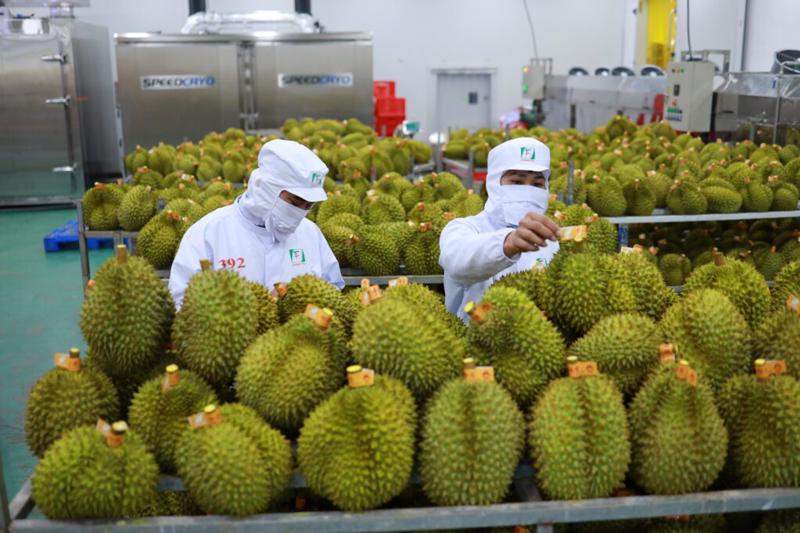Agricultures, Foods, News & Event
Promoting export of Vietnamese agricultural products through planting area codes
The granting of planting area codes and packing facilities is considered a “passion ticket” to help Vietnamese agricultural products firmly export through official channels to many markets around the world, opening up opportunities for businesses and contributing to the socio-economic development of the country…

Over the years, the activity of granting planting area codes and packing facilities has achieved many positive results, contributing to improving the reputation of Vietnamese agricultural products in the international market and increasing export turnover. Thereby helping to change farming practices, promote production according to market standards and tastes, and guide farmers to more professional production practices.
PROTECTION OF THE PASSPORT FOR AGRICULTURAL PRODUCTS FOR EXPORT
China is one of Vietnam’s major fruit export markets, official fruit exports through China thanks to signed protocols have helped this fruit attract goods, increase prices, and bring in more revenue. good income for many farmers. Accordingly, the protection of the growing area code, packaging or investment in quality becomes a mandatory requirement.
In the first four months of this year, fruit and vegetable exports reached nearly $1.4 billion, up 19% over the same period in 2022. While many export markets such as the US and EU declined, the Chinese market declined. growing very well. Currently, in order to export to China, agricultural products must be certified with the planting area code and packing facility. This is considered a “visa” for fruit when exporting.
According to statistics, nationwide, there are nearly 6,500 growing areas in 53/63 provinces and cities and 1,600 packing facilities in 33 provinces and cities that have been granted export codes. At the same time, there are 25 products granted export codes such as dragon fruit, longan, lychee, mango, rambutan, custard apple, lemon, grapefruit, mangosteen, watermelon, jackfruit, sweet potato, durian, etc. markets: China, USA, Australia, New Zealand, Korea, Japan, EU, Thailand, UAE, Malaysia…
The establishment of planting areas to issue codes will include determining the area, using a uniform production process in the planting area, controlling harmful organisms on the list of subjects subject to plant quarantine of countries, have a farming diary, good agricultural practices, at least according to VietGAP process.
However, in parallel with the results achieved, there is also an increase in fraudulent or revoked planting area codes. According to the Plant Protection Department, the Ministry of Agriculture and Rural Development has more than 710 planting area codes that have been revoked. Planting area codes across the country have been revoked, mainly in the provinces of Tien Giang, Tay Ninh, Lam Dong, Binh Thuan, etc., of which most are agricultural products exported to China. The main reason is not meeting the technical quality requirements of the importing country.
Besides, there is also another big reason why many planting area codes have been revoked because many localities only pay attention to the newly issued codes but have not paid attention to maintaining and monitoring the issued codes. This leads to old growing areas that are not strictly monitored, are not fully recorded in farming logs, often lack a lot of information or are inconsistent in the records or the actual inspection.
Many planting area codes have not properly applied pest management measures, especially pest control according to ISPM standard No. 6, no measures to manage and monitor pesticide residues. object…
In order to promote Vietnamese agricultural products to have more international “passport tickets”, the Ministry of Agriculture and Rural Development has also issued Directive No. 1838/CT-BNN-BVTV on strengthening the management of area codes. planting and packing facilities for agricultural products for export.
The directive clearly states that industry associations need to strengthen propaganda for their members on regulations on codes of growing areas and packing facilities, especially plant quarantine and food safety of importing countries. At the same time, coordinate with the Plant Protection Department and the local focal agency to provide technical support to members actively participating in the development of the planting area codes and local packing facilities for export.
EXPORTING SEPARATE DRUG SUCCESSFULLY POSITIVE RESULTS
According to statistics of the General Department of Customs, the Ministry of Finance, durian was the highest-growing export fruit in the fruit and vegetable industry in the first quarter of 2023, with a value of USD 153 million, an increase of 8.3 times compared to the previous quarter. with the same period last year.
Continuing the growth momentum, in the first 5 months of 2023, the export volume of fresh durian fruit reached over 65,000 tons, up 41% compared to the whole year of 2022. In which, China is the largest fresh durian export market. of Vietnam, accounting for about 97%.
One of the positive signs for Vietnamese durian is that recently, the Plant Protection Department, Ministry of Agriculture and Rural Development has received a document from the General Administration of Customs of China (GACC) announcing the results of the review. Approving the remedial records of the growing area codes, durian establishments did not pass the online test in January 2023.
Accordingly, Vietnam has 47/51 more growing areas and 18 packaging facilities that meet the requirements and have been granted an export code by GACC to China. In addition, 4 unsatisfactory planting area records are due to incomplete information and unclear images, so the GACC side could not evaluate the improvement. Thus, up to now, Vietnam has 293 growing areas and 115 durian packing facilities that have been granted export codes to this market by China.
Currently, the Plant Protection Department is working with GACC to agree on the next online inspection schedule for about 400 growing areas and 60 durian packing facilities that have sent documents to the Chinese side. After agreeing on the inspection schedule and content, the Department will notify the localities to proactively prepare and coordinate the implementation of the GACC’s plan.
Having more planting area codes and durian packing facilities approved by China is good news for durian growers and exporters. This is a favorable condition for Vietnamese enterprises to increase the output and export value of durian to China in the remaining months of 2023 when the consumption demand from this market is very large.
However, if compared with Thailand, which has tens of thousands of growing area codes and packaging facilities to export durian to the Chinese market, it is clear that this is something that the Vietnamese durian industry needs to make more efforts. to compete with other countries in the region.
Source: https://vneconomy.vn/thuc-day-xuat-khau-nong-san-viet-thong-qua-ma-so-vung-trong.htm
